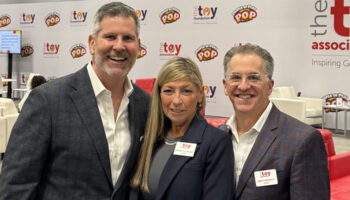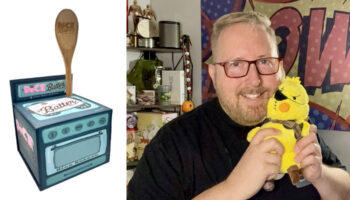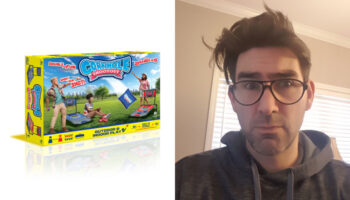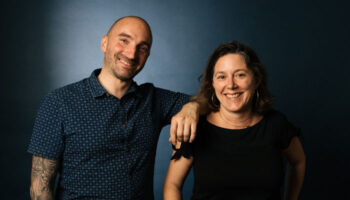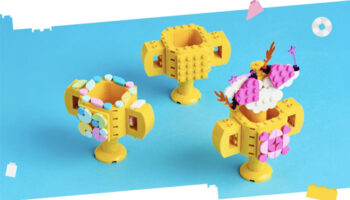Otrio inventor Brady Peterson on dreaming ideas, pitching and what’s next…

Serial inventor Brady Peterson on Otrio, magnets… And the BIG lesson he learned early.
You describe yourself as a “tinkerer”. That word comes up quite a bit with people of a particular mindset – but how do you define it?
Boy, good question. I guess for me it means to take a product idea and turn it into a physical form. Over the past few years I’ve assembled a nice set of maker tools – an SLA 3D printer, CNC machine, a laser cutter. I’ve also become somewhat proficient with a 3D solid-modelling app, so – for me – it’s relatively straightforward to bring simpler ideas to life pretty quickly.
So what’s the hard part?
With limited ‘tinkering time’, the real challenge recently is to pick which ideas are worth the time and effort given my other responsibilities… A consulting day job, family time, plus marketing, selling and shipping the Inventor’s Edition of my game Otrio.
The Inventor Edition is beautiful! I shouldn’t get ahead, though; let’s come back to Otrio… Growing up, then, with which toys and games did you play?
I know I’m ageing myself, and I’m sure I’ve forgotten many things that occupied my time as a youngster… But the games that rise to the top of my memory a bit are Monopoly, Uno, Euchre and Cribbage. I also had an Atari 2600 and loved games like Pitfall and Dig Dug.

Oh my days! Dig Dug! Yes! And there were toys, presumably?
Yes. I had some model rockets… There was also LEGO – obviously! And I had Evel Knievel’s Stunt Cycle which was so good! Stretch Armstrong I had until he got a nick – and all the red oozy stuff came out. Of course, I had everything Star Wars from ’77 to ’83, much of which I still have boxed up. Oh! And I had Huffy’s Green Machine which was soooo much better than the Big Wheel in my opinion.

Big Wheel and Huffy’s Green Machine… I don’t think I know those?
They’re trikes! I’ll send you some links, you can judge for yourself! Other than that, I grew up by a lake in rural Wisconsin… So most of our play time was spent outdoors adventuring & role playing using the primitive materials at hand – sticks for swords; towels for capes. Quite a bit different than what today’s youth mostly experiences, but some of my fondest memories from back in the day.

And what’s your background? How did you get into the industry?
I have an undergraduate mechanical engineering degree and an MBA. I stumbled into the industry around a decade before I actually even knew it. I had a class as part of my MBA in which we needed to come up with a new product, and then develop a marketing and sales plan to bring it to the masses.
As I pondered various product ideas, I somehow came up with the word imagineit in a dream one night. I woke up and wrote it down on a piece of paper by my bedside, then went back to sleep. By the time I arose, I’d forgotten about the dream – but I noticed the note and immediately thought the name – which contains both the words MAGNET and IMAGINE – would be the perfect name for a creative magnetic product. I ended up dropping the MBA class, but developing a magnetic toy became somewhat of an obsession.
Just to be clear, when was this?
This was in 2002. Needless to say, it took a bit of time – it was more than a decade before I pitched a magnetic toy! There were some gaps in the progress, and a whole lot of scrap magnets, sawdust and other materials… The concept I showed Mindware at ChiTag in 2014 was about the 158th I developed.
Good grief! I’m magnet mad myself, but I can’t imagine going that far! Just before we carry on, what is it about magnets you find compelling?
Well, magnets are – to use a phrase commentator Stuart Scott liked – about as cool as the other side of the pillow! I mean, what’s not to like? They have this built in power that never needs batteries, you can invisibly move things with them, rearrange them to build a never-ending variety of structures – hello Magformers – or just toss them like Ninja throwing stars… Flingons, anyone?
As a side note, I should say I trademarked the iMAGINEiT name, am currently selling magnets under the brand on Etsy… And am now working on additional magnetic toy & game concepts.

Okay! Sorry; I interrupted; you pitched concept 158… Was it a winner?
Well, fortunately they liked the prototype and had an opening in their line, so I was able to sign my first licensing agreement. They weren’t as fond of the name imagineit , so they called it MagnaMix. In addition to that breakthrough event, I was super lucky: the toy went into Target stores in 2015.
And is it still in store?
I’m even more fortunate in that respect – yes, it’s still on their shelves! After that first license, and with all the assistance that Mary Couzin’s annual ChiTag events had to offer, I’ve been able to license around a dozen toys and games over the past five years, co-launch the game company Playtacular and start selling an Inventor’s Edition of my game Otrio.
So… Otrio is your first published game… There’s the Inventor Edition, a regular one, a travel version, a larger set made in wood… How would you describe the game itself?
I’ve heard people describe it as Tic-Tac-Toe on steroids, but I’m not terribly fond of that analogy. I like to think of it as a brainier, edgier & more modern take on the classic game.

In much of Britain, Tic-Tac-Toe is known as Noughts and Crosses, of course, or X’s and O’s… So what’s a better way to describe Otrio?
One of my favourite quotes pretty much sums up how I feel about it. In an amazon review, Dave L. says: “Simple concept, difficult to master. Easy enough for my five-year-old to play, difficult enough to lose to that same five-year-old.”
That’s about right! It’s deceptively-simple looking. For those that don’t know it, you have to get three of your nine coloured circles in certain positions… But that’s easier said than done! You really have to pay attention. What’s the story behind it?
Otrio was birthed as a result of a random moment of inspiration created by an everyday object. It was late 2014, and my company’s cafeteria was being renovated. The first thing that caught my eye when it reopened were these new booths covered in this funky, multi-colour, circle-pattern fabric. At that moment, I knew I needed to try to come up with a circular-themed game.

You’re just sitting in a café, looking at the décor… And you’re inspired to develop a game?! Let’s get into that! What questions are you asking yourself in that booth? What happens next?
I thought the booths looked cool so I took a picture, and a few weeks later set out to design my first board game. I was just envisioning it as somehow circle-themed… Before I had any idea as to how the gameplay would work, I drew up a board that housed concentric circles, had one cut out of plywood, and 3D printed a set of multi-colour pieces. They were the concentric circles. Then I had a few friends over to playtest the prototype.
So what gameplay were you testing?
Initially, we tried a chess or checkers style mechanic; you had to capture a piece. That bombed in about the first ten minutes! We then began playing Tic-Tac-Toe style, using the concentric pieces. After just a few rounds it became pretty apparent there was something there.

And did the finished version keep developing there and then?
It evolved a bit more that night and in the weeks to come. About a month later, I pitched it to Marbles the Brain Store, to whom I’d been introduced at ChiTAG in 2014. We ended up signing a licensing agreement a few months later.
How long did all this take?
The game moved pretty quickly through the development process. It launched in the fall of 2015. Fortunately, Otrio has gone on to win a few awards and sell over 300,000 units worldwide. In addition, that same funky, circle-patterned fabric was the inspiration behind another toy l designed – Pattern Play Revolution by Mindware. It also launched that fall.

Thank gawd the café didn’t have triangles! You mention pitching to Marbles the Brain Store… How do you find pitching?
I really enjoy it, especially since a good many of the people I pitch to have become personal friends. So a lot of times, I already have a good relationship before the pitch even begins. If not, I enjoy learning a bit about the people I’m pitching to and letting them know a little bit about me before we get into the substance of things – time permitting, of course.
And what pitching tips do you have for others?
I think pitching has changed quite a bit since I’ve last had a good round of it – what with sizzle videos and Zoom calls versus doing it in-person! But I think most of what worked well for me in the past still holds true… First and foremost, I’d say do your research and make sure your idea isn’t already on the market – and hasn’t been previously.
This sounds like experience talking!
Well, when we first started Playtacular we had a game idea – Chicken Butt – which we thought was absolutely amazing. I spent a good month 3D printing prototypes until we had a great working version. We then set up several meetings to pitch. At the very first meeting, we found out something similar had already been introduced – Lay It or Break It. In our minds, the gameplay differed enough – but it was just too similar to justify a company expending resources to bring our game to market. Big lesson learned there.

From everything you say, I take it you prototype quite heavily?
Yes. I know there are different opinions on this, but my personal mantra is to make the best prototype possible for your pitch meetings. You likely only get one chance to pitch an idea to a given company, so it pays to make it look and perform as closely to how you envision it on shelf as possible. I think companies are busier than ever, so the less they need to use their imaginations to see what it ‘could be’, the better.
I’d also say research the companies you’re pitching to prior to your meetings. You must make sure you only pitch ideas that are in line with products they already carry, or that you know they’re looking to carry. This seems obvious but I’ve seen many people pitch all their ideas to every company they can set up a meeting with. But it makes no sense to pitch a board game to a toy bike manufacturer!
Agreed. And one last tip?
Know when to move on! Although it’s easy to become married to an idea, there comes a time to move on and look for other opportunities. If you pitch something to many companies and you have minimal interest – or none – start looking for other ideas to move forward. This can be very hard, especially for new inventors, but seasoned inventors know it’s a quantity game. The more ideas you come up with, the more that can percolate to the top and become viable licensable options.

Excellent. Let me ask you this… If you had a magic wand and could change any part of the journey from idea to market, which part would it be?
Hmm… Okay, I have one. I’d snap my fingers and be able to go straight from signing the licensing agreement to having the product show up for sale on store shelves, or online.
Because the development process seems long?
Well, I’d say most of the time I’ve had very limited involvement in the development process – which isn’t all that unusual… So it’s just a waiting game of many, many months to see how the product turns out in its final form. That, plus it’s really nice to get those royalty checks to start flowing as quickly as possible.
Good answer. What’s next for you?
I’ll start work on a small line of games to sell directly to the consumer online. In line with Shopify’s five trends for the future of e-commerce in 2021, I think there’s a huge opportunity for small businesses selling DTC and controlling the entire customer experience. There are numerous challenges for sure, but the benefits are tremendous and likely to continue, if not accelerate, in the post-pandemic era. I’ll also focus on bringing the Inventor Edition of Otrio to international markets. Can I insert a shameless plug here to check out otrio.com?

You can – and we’ll put in a picture of the posh Otrio! Before we start wrapping up, which question have you never been asked in an interview that you think it might be interesting to answer?
Ironically, one of the most basic questions: What did your child-self want to be when he grew up?
And what did your child-self want to be when he grew up?
As I mentioned earlier, I grew up in rural Wisconsin, so I dreamt of becoming a professional fisherman – a fisherman, and / or a taxidermist. Yeah, maybe I should have kept that one to myself!
No, it’s a good answer! Okay… One last question: what’s the most interesting thing on your desk?
It’s a meteorite that was given to us as a gift for our wedding. No idea if it’s legit or not… But regardless of that, it’s fascinating for me to think about all it’s seen since its inception, and on through its journey to my tiny-little desk.

Brady, this has been nothing but a pleasure. Thank you so much for making time. Happy New year to you; stay safe and be well.
Thanks to you as well – and here’s to wishing our planet and everyone on board a much better 2021!
—-
To stay in the loop with the latest news, interviews and features from the world of toy and game design, sign up to our weekly newsletter here





